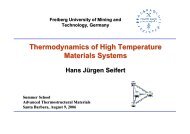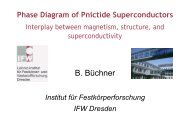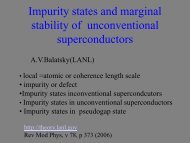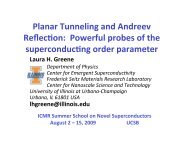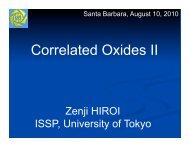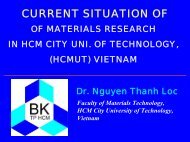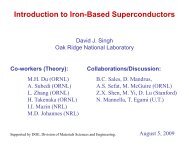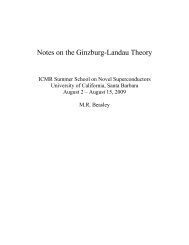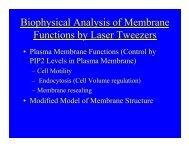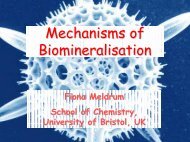Materials Research in Thailand - International Center for Materials ...
Materials Research in Thailand - International Center for Materials ...
Materials Research in Thailand - International Center for Materials ...
You also want an ePaper? Increase the reach of your titles
YUMPU automatically turns print PDFs into web optimized ePapers that Google loves.
<strong>Materials</strong> <strong>Research</strong> <strong>in</strong> <strong>Thailand</strong><br />
Cattleya Petchs<strong>in</strong>gh, Voravee Hoven, Sujitra Wongkasemjit
<strong>Materials</strong> <strong>Research</strong> <strong>in</strong> <strong>Thailand</strong><br />
Cattleya Petchs<strong>in</strong>gh, Voravee Hoven, Sujitra Wongkasemjit<br />
• Popular areas of research<br />
• Active <strong>in</strong>stitutes and universities<br />
• <strong>Research</strong> culture<br />
• Typical difficulties<br />
• Case studies<br />
• Possible collaborations
Areas of research<br />
Th<strong>in</strong> films<br />
Inorganic<br />
sensors &<br />
solarcells<br />
Polymers<br />
sensors, rubber<br />
packag<strong>in</strong>g<br />
Bio<br />
Characterisation<br />
Ceramics<br />
Textiles<br />
Metal<br />
Others<br />
Nano<br />
Composites<br />
What ?
Universities<br />
• Chulalongkorn<br />
• Mahidol<br />
• Silapakorn<br />
• Kasetsart<br />
• Thammasat<br />
• KMITL<br />
• KMUTT<br />
• RIT<br />
• AIT<br />
• Chiangmai<br />
• Naresuan<br />
• Pr<strong>in</strong>ce of Songkla<br />
• Walailak<br />
• Suranaree<br />
• Khonkhan<br />
<strong>Research</strong> centres<br />
• MTEC<br />
• NECTEC<br />
• NANOTEC<br />
• BIOTEC<br />
• Rubber <strong>Research</strong><br />
Institute<br />
• NSRC<br />
80-20<br />
Where ?
<strong>Research</strong> culture<br />
Various small research clusters:<br />
<strong>in</strong>ternationally educated and active members (600+)<br />
Government Applied and device-based research<br />
Grants from government<br />
fund<strong>in</strong>g body to <strong>in</strong>dividual<br />
researchers/projects<br />
Basic equipment:<br />
scattered <strong>in</strong> different<br />
<strong>in</strong>stitutes<br />
Advanced equipment: some are<br />
available <strong>in</strong> research centres<br />
(high demand)<br />
Many are not cont<strong>in</strong>ued nor<br />
implemented <strong>in</strong> <strong>in</strong>dustries<br />
How ?
Typical difficulties<br />
• Many small research clusters<br />
• <strong>Research</strong> directions are guided by available<br />
equipment, government strategies, and<br />
exist<strong>in</strong>g clusters<br />
• No <strong>in</strong>dustries to back up<br />
• No ma<strong>in</strong>tenance budget <strong>for</strong> equipment<br />
• Imported technology: technical support is<br />
limited<br />
• Limited access to advanced labs<br />
• Lack of hi-tech/specific equipment Why ?
Physics at Thammasat<br />
• 17 academic staff – 4 research active<br />
• 60 students/yr 20-30 graduates/yr<br />
• MSc start<strong>in</strong>g next year<br />
• No Doctoral programme (yet)<br />
Current research <strong>in</strong>cludes<br />
• X-ray diffraction of small molecules<br />
• Ag-Au nanoparticles<br />
• Physical and Electrical Properties of PZT Ceramics<br />
• Optical characterisation of QDs/CNTs
Case study 1: Nanomaterials<br />
P A Shields et al. APL (2004)<br />
•MOCVD<br />
• Sample preparation<br />
(lithography, bond<strong>in</strong>g etc.)<br />
•PL/EL<br />
• Magneto-optical<br />
spectroscopy<br />
• Excitation spectroscopy<br />
EL (V)<br />
7.0x10 -6<br />
6.0x10 -6<br />
QW<br />
5.0x10 -6<br />
4.0x10 -6<br />
3.0x10 -6<br />
2.0x10 -6<br />
1.0x10 -6<br />
0.0<br />
0 s<br />
4 s<br />
15 s<br />
60 s<br />
600 s<br />
1600 1800 2000 2200 2400 2600 2800 3000<br />
Wavelength (nm)
Case study 1: Nanomaterials<br />
CMU, TU, NANOTEC<br />
P S<strong>in</strong>gjai et al, Chem Phys Lett 366/1-2 p51 (2002)
Case study 1: Nanomaterials<br />
SEM, AFM, TEM<br />
Raman spectroscopy Excitation spectroscopy<br />
X-ray based methods
Case2:<br />
Polymer-related <strong>Research</strong> <strong>in</strong><br />
<strong>Thailand</strong><br />
12<br />
12/1/2005
Active Fields I<br />
• Natural Polymer : NR, chit<strong>in</strong>-chitosan<br />
• Chemical Modification<br />
• Process<strong>in</strong>g<br />
• Synthetic Polymer<br />
• Synthesis : i.e. conduct<strong>in</strong>g, biodegradable<br />
• Characterization and Process<strong>in</strong>g<br />
• Blends and composites<br />
•Recycl<strong>in</strong>g<br />
13<br />
12/1/2005
Active Fields II<br />
• Polymer <strong>for</strong> Biomedical Application<br />
• Drug Delivery<br />
• Tissue Eng<strong>in</strong>eer<strong>in</strong>g<br />
• Polymer <strong>for</strong> Nanotechnology<br />
• Th<strong>in</strong> Film<br />
• Nanocomposite<br />
• Biosensor and Chemical Sensor<br />
• Textiles
Chulalongkorn University<br />
•1 st University established <strong>in</strong> 1917<br />
• 18 Faculties + 11 research <strong>in</strong>stitutes<br />
+ 3 teach<strong>in</strong>g <strong>in</strong>stitutes<br />
+ 3 affiliated <strong>in</strong>stitutes<br />
• 500-acre campus located <strong>in</strong> the<br />
heart of Bangkok<br />
• 30,000 students and 2,800 faculty
Faculty of Science<br />
• Chemistry<br />
• Physics<br />
• Mathematics<br />
• Biology<br />
• Biochemistry<br />
• Botany<br />
• General Science<br />
• Geology<br />
• Mar<strong>in</strong>e Science<br />
• Microbiology<br />
• Chemical Technology<br />
• Food Technology<br />
• <strong>Materials</strong> Science<br />
• Photographic Science<br />
& Pr<strong>in</strong>t<strong>in</strong>g Technology
Department of Chemistry<br />
Facts and Figures
Curriculum<br />
• Undergraduate Level : 400 B.Sc.<br />
• Service Courses: 45 lectures, 22 labs, ~3,000<br />
students/year <strong>in</strong> Medical Science and Eng<strong>in</strong>eer<strong>in</strong>g,<br />
Science Major<br />
• Regular: major/m<strong>in</strong>or program, honor program<br />
• <strong>International</strong> Program <strong>in</strong> Applied Chemistry<br />
• Graduate Level : 250 M.Sc., 80 Ph.D.<br />
• Basic Fields : analytical, <strong>in</strong>organic, organic,<br />
physical<br />
• Applied Fields : Petrochemistry, Polymer Science,<br />
Biotechnology, Environmental
Faculty and Staff<br />
Faculty members: 78 (46 members aged 25-40)<br />
Physical<br />
(13)<br />
Division<br />
Organic (31)<br />
Educational Background<br />
MS (12) BS (2)<br />
Analytical<br />
(22) Inorganic<br />
(12)<br />
PhD (64)<br />
Support<strong>in</strong>g staff: 45
Library<br />
Facility<br />
7 th –15 th Floor<br />
Classroom<br />
Computer Room<br />
Computer Room<br />
Mahamakut Bldg
Instrument<br />
• 400 MHz NMR Spectrometer<br />
• MALDI-TOF<br />
• GC-MS Spectrometer<br />
• LC-MS Spectrometer<br />
• Atomic Absorption Spectrometer<br />
• HPLC<br />
• IR Spectrometer<br />
• UV-Vis Spectrophotometer<br />
• Capillary Electrophoresis<br />
• Potentiometric Titrator + Cyclic Votammetry<br />
• X-ray Diffractometer
<strong>Research</strong> Unit<br />
Environmental Analysis<br />
Functional Polymer & Petrochemistry<br />
Natural Products<br />
Bioorganic Chemistry<br />
Sensor<br />
<strong>Materials</strong> Chemistry and Catalysis<br />
Organic Synthesis<br />
Supramolecular Chemistry<br />
Chromatography and Separation<br />
Computational Chemistry<br />
Chemical Education
Surface Chemistry and Beyond<br />
• Chemical Modification and Characterization of<br />
Polymer Surface<br />
• Functional Organic Th<strong>in</strong> film <strong>for</strong><br />
Biotechnology and Nanotechnology<br />
• Polymer <strong>for</strong> Biomedical Application<br />
24<br />
12/1/2005
Polymer Brushes : Previous work<br />
CH 2<br />
CH 3<br />
C<br />
C<br />
O<br />
n<br />
O<br />
O<br />
CH 2 CH 2 O P<br />
O - O CH 2 CH 2 N + (CH 3 ) 3<br />
Poly(2-Methacryloyloxyethyl phosphorylchol<strong>in</strong>e)<br />
(PMPC)<br />
• High stability<br />
• High graft density<br />
• Reduction of prote<strong>in</strong> adsorption<br />
• Suppression of platelet adhesion<br />
and activation
Polymer Brushes : Previous work<br />
UV irradiation<br />
ATRP<br />
of<br />
MPC<br />
Si/SiO 2<br />
λ= 185 nm, 3.5h<br />
Photo-mask<br />
Non-irradiated region<br />
Incubate with FITCbov<strong>in</strong>e<br />
serum<br />
album<strong>in</strong>/PBS(4.5g/dL)<br />
<strong>for</strong> 30 m<strong>in</strong> at 37 °C<br />
UV-irradiated region<br />
Fluorescence image
Polymer Brushes : Previous work<br />
Mesh size of photo-mask<br />
L M S<br />
Thickness<br />
~12 nm<br />
Polymerization time: 18 h<br />
Polymer thickness: 12 nm<br />
50 µ m 50 µm<br />
After seed<strong>in</strong>g with Mouse fibroblasts (L-929 cells), 20h, 5x10 4 cells/mL
Polymer Brushes : Current work<br />
• A novel precursor sens<strong>in</strong>g layer<br />
:Carboxyl-conta<strong>in</strong><strong>in</strong>g polymer brushes<br />
(l<strong>in</strong>ear and branched)<br />
• Responsive ‘Smart’ surface :<br />
Semifluor<strong>in</strong>ated Block Polymer Brushes<br />
• Limitation : Fabrication Facilities, XPS
Biosensor<br />
Peptide-nucleic Acid – Based<br />
Biosensor<br />
29<br />
12/1/2005
Peptide Nucleic Acid<br />
• DNA-mimic<br />
• Peptide l<strong>in</strong>kage<br />
• Superior b<strong>in</strong>d<strong>in</strong>g<br />
stability & specificity
Quartz Crystal Microbalance (QCM)<br />
• Limitation : Fabrication Facilities, SPR
Case Study 3:<br />
The Petroleum and Petrochemical College<br />
Chulalongkorn University
THE PETROLEUM AND PETROCHEMICAL COLLEGE<br />
CHULALONGKORN UNIVERSITY<br />
<strong>in</strong> academic partnership with<br />
THE UNIVERSITY OF MICHIGAN (UM), USA<br />
THE UNIVERSITY OF OKLAHOMA (OU),<br />
USA<br />
CASE WESTERN RESERVE UNIVERSITY (CWRU),<br />
USA<br />
and<br />
INSTITUT FRANçAIS DU PéTROLE (IFP), FRANCE<br />
announces its<br />
The Petroleum and Petrochemical College<br />
<strong>International</strong> Master and Doctor of<br />
Philosophy Degree Programs<br />
<strong>in</strong><br />
Petroleum Technology<br />
Petrochemical Technology<br />
and<br />
Polymer Science
PETROLEUM<br />
TECHNOLOGY<br />
Core Courses (Total 12 credits):<br />
Petroleum Ref<strong>in</strong><strong>in</strong>g: Technology and Economics<br />
Natural Gas Process<strong>in</strong>g<br />
Advanced Chemical Eng<strong>in</strong>eer<strong>in</strong>g Thermodynamics<br />
Advanced Fluid Mechanics<br />
Elective Courses (Total 12 credits):<br />
Petroleum Bus<strong>in</strong>ess: Structure, Logistics and Economics<br />
Oil and Gas Process Safety and Environment<br />
Advanced Equilibrium Stage Operations<br />
Advanced Combustion Process<br />
Process Simulation and Design<br />
Heterogeneous Catalysis
PETROCHEMICAL<br />
TECHNOLOGY<br />
Core Courses (Total 12 credits):<br />
Transport Phenomena<br />
Advanced Chemical Eng<strong>in</strong>eer<strong>in</strong>g Calculations<br />
Advanced Chemical Eng<strong>in</strong>eer<strong>in</strong>g Thermodynamics<br />
Chemical Reaction Eng<strong>in</strong>eer<strong>in</strong>g<br />
Elective Courses (Total 12 credits):<br />
Heterogeneous Catalysis<br />
Natural Gas and Upstream Petrochemicals Process<strong>in</strong>g<br />
Colloid and Surface Science<br />
Petrochemical Industry: Technology and Economics<br />
Process Simulation and Design<br />
Others
POLYMER SCIENCE<br />
Core Courses (Total 12 credits):<br />
Polymer Synthesis<br />
Physical Chemistry of Polymers<br />
Polymer Physics<br />
Polymer Process<strong>in</strong>g<br />
Elective Courses (Total 12 credits):<br />
Polymer Characterization<br />
Rheological Properties of Polymers<br />
Inorganic and Organometallic Polymers<br />
Science and Technology of Fibers<br />
Advanced Polymers and Composite <strong>Materials</strong> and<br />
Others
FACULTY<br />
The programs are taught jo<strong>in</strong>tly by the College’s<br />
faculty and professors from the partner <strong>in</strong>stitutions who<br />
also supervise students’ thesis work <strong>in</strong> collaboration<br />
with the College’s faculty.<br />
The Petroleum and Petrochemical College
<strong>Research</strong> Facilities and Equipment<br />
> 300 Million baht (US$ 6 M) 8 floors - 7,000 m 2<br />
<strong>Research</strong> Equipment<br />
Chromatography<br />
HPLC, GC, GC-Headspace, GC (Simdist(<br />
Simdist),<br />
GPCs (RT-HT)<br />
Spectroscopy<br />
AAS, ICP, UV-VIS, VIS, UV –VIS Colorimeter, GC/MS (HR and<br />
Quadrupole), FTIR, FTIR-Raman, Raman, Laser Raman, XRD<br />
Microscopy<br />
SEM, Polarizer, Zoom Stereo<br />
The Petroleum and Petrochemical College
Surface and Interfacial Analysis<br />
Physi-Chemisorption<br />
Chemisorption, , TPD/TPR, Particle size analyzer,<br />
Sorptomatic,TPDRO/MS,<br />
Tensiometers (DuNouy,, Sp<strong>in</strong>n<strong>in</strong>g drop,<br />
Drop shape analyzer, Bubble pressure), Zeta-meter<br />
Thermal Analysis<br />
TGA, DSC, STA, EA, TG-DTA, DSC, DMA<br />
Petroleum Test<strong>in</strong>g<br />
Environmental Analysis<br />
TOC, Microwave<br />
Polymer Test<strong>in</strong>g<br />
Polymer Process<strong>in</strong>g<br />
The Petroleum and Petrochemical College
• Environmental Catalysis<br />
- NO X<br />
& CO reductions<br />
- VOC reduction<br />
• Methane Re<strong>for</strong>m<strong>in</strong>g<br />
• Photocatalytic Reactions<br />
• Hydrocarbon Process<strong>in</strong>g<br />
& Catalysis<br />
• Thermal Conversion:<br />
Gasification, Pyrolysis<br />
• Bio Fuels<br />
The Petroleum and Petrochemical College<br />
Catalysis Lab
Colloid and Surface Science Lab<br />
The Petroleum and Petrochemical College<br />
• Admicellar Catalysis &<br />
Polymerization<br />
• Microemulsions<br />
• Foam<strong>in</strong>g & Detergency<br />
• Froth Floatation<br />
• Surfactant-Based<br />
Separation<br />
Processes<br />
• Bio Surfactants
Polymer Process<strong>in</strong>g and Test<strong>in</strong>g Labs<br />
• Injection mold<strong>in</strong>g<br />
• Blow mold<strong>in</strong>g<br />
• Blown film extruder<br />
• Tw<strong>in</strong> screw extruder<br />
• Universal test<strong>in</strong>g mach<strong>in</strong>e<br />
(Instron<br />
& Lloyd)<br />
• Stress crack<strong>in</strong>g tester<br />
• Fiber/film shr<strong>in</strong>kage tester<br />
The Petroleum and Petrochemical College
Rheology Lab & Central Instrument Lab<br />
Gas Sensor<br />
Unit<br />
Rheometer<br />
TGA<br />
The Petroleum and Petrochemical College<br />
SEM<br />
Optical Polariz<strong>in</strong>g<br />
Microscope
Industrial Short Courses<br />
• Applied Surfactant Science and<br />
Technology<br />
• Natural Gas Process<strong>in</strong>g<br />
• Heterogeneous Catalysis<br />
• Petroleum and Petrochemical Industries:<br />
Technology and Economics<br />
• Hazardous Waste Management<br />
• Plastics: <strong>Materials</strong>, Process<strong>in</strong>g and<br />
Test<strong>in</strong>g<br />
• Blow/Injection Mould<strong>in</strong>g Technology<br />
• Rheology and Industrial Applications<br />
• GAS and LNG<br />
The Petroleum and Petrochemical College
Variety of Synthesized Catalysts/Catalyst<br />
Supports<br />
c<br />
K-H Zeolite<br />
ZSM-5<br />
Silica Fiber<br />
F<strong>in</strong>e Silica<br />
FAU<br />
ZSM-5<br />
MCM-41<br />
TS-1<br />
LTA GIS ANA<br />
The Petroleum and Petrochemical College<br />
Fe-ZSM-5
Hydrogen Production By Autothermal System<br />
Over Ce/Zr Mixed Oxides<br />
• Promote steam re<strong>for</strong>m<strong>in</strong>g and water-<br />
gas<br />
shift reactions<br />
• Decrease coke <strong>for</strong>mation<br />
• Catalyst preparation - Sol-Gel<br />
technique<br />
The Petroleum and Petrochemical College
Mixed Matrix Membrane (MMX)<br />
• Alter permeability and selectivity of the orig<strong>in</strong>al<br />
membrane<br />
(olef<strong>in</strong>/paraff<strong>in</strong>)<br />
• C 2<br />
H 4<br />
/C 2<br />
H 6<br />
separation<br />
Zeolite/Cellulose Acetate<br />
Mixed Matrix Memebrane<br />
The Petroleum and Petrochemical College
Carbon Nanotubes<br />
Nanotubular structure of carbon<br />
• Strongest fiber known to<br />
human<br />
with excellent electronic<br />
properties<br />
• Applications:<br />
New composite material<br />
Nanocircuit<br />
Nanotechnology<br />
The Petroleum and Petrochemical College
Modification of Cotton Properties -> > Hydrophobic Cotto<br />
***Patent Pend<strong>in</strong>g***<br />
Untreated<br />
cotton<br />
Modified<br />
cotton<br />
Sample of untreated cotton and modified cotton by<br />
us<strong>in</strong>g admicellar polymerization technique.<br />
Water-repellent<br />
repellent<br />
The Petroleum and Petrochemical College<br />
Soil-resistant<br />
Fire-retardant<br />
retardant
Development of Chitosan <strong>for</strong> Drug Controlled Release<br />
System<br />
The Petroleum and Petrochemical College
Development of Conductive Polymer <strong>for</strong> Gas Sensor<br />
• Polymer which exhibits electrical conductivity higher than 10 -10<br />
S/cm<br />
(Agbor,, 1989).<br />
• Detect CO, SO 2 , NO X , NH 3 , H 2 S Polyanil<strong>in</strong>e<br />
Dop<strong>in</strong>g Process<br />
Insulat<strong>in</strong>g Polymer<br />
Chargers are<br />
removed or<br />
added<br />
Conduct<strong>in</strong>g Polymer<br />
H H<br />
N N N N<br />
n<br />
Protonic acid<br />
Dop<strong>in</strong>g<br />
H H H H<br />
N<br />
..<br />
N N N<br />
. + .. . +<br />
Cl -<br />
Cl -<br />
H H H<br />
N N N<br />
.. .. ..<br />
Oxidative Dop<strong>in</strong>g<br />
s = 10 -10 S/cm<br />
s >100 S/cm<br />
s = 10 -10 S/cm<br />
The Petroleum and Petrochemical College
RHEOLOGY OF IMMISCIBLE POLYMER<br />
BLENDS
CONCLUSIONS: Possible collaborations<br />
• Exchange of staff/students with Thai<br />
universities – access of exist<strong>in</strong>g facilities<br />
• <strong>Thailand</strong> should be a good base <strong>for</strong> tra<strong>in</strong><strong>in</strong>gs<br />
and workshops<br />
• Fund<strong>in</strong>g <strong>for</strong> post-graduate students<br />
• Technology transfer and know-how on<br />
advanced equipment / techniques<br />
• Jo<strong>in</strong>t projects (fund<strong>in</strong>g ?)



